Disclosure: Meeple Mountain received a free copy of this product in exchange for an honest, unbiased review. This review is not intended to be an endorsement.
Bacon. It’s great! Here at the Bell household, we do a big breakfast every Sunday and bacon is usually on the table. (By “bacon”, I mean the pork stuff; turkey bacon is, well, not for me.)
I can’t really say I’ve ever had bad bacon. Like, bacon that I took one bite of, then did a “spit take” and threw that slice away. All pork bacon is at least decent bacon, so I’m never gonna pass that up.
Ascension: Deckbuilding Game was my introduction to deckbuilders a decade ago. Nowadays, I mostly play Ascension on my iPad as a filler activity between other tasks. I’m sure I have played over 500 rounds of the game that way, along with a handful of in-person plays. I love the base game and I’ve played 6-7 of the expansions now, mostly the early stuff like Storm of Souls and some of the first promo packs.
I met Justin Gary at GAMA Expo back in March, and while that was a career milestone for me (who doesn’t love meeting their game design heroes?), I was mostly excited to get a review copy of Ascension Tactics: Miniatures Deckbuilding Game to the table.
If you remember that there’s no such thing as bad bacon, and you are a fan of Ascension, you’ll be in at least decent shape with Ascension Tactics. Whether this becomes elevated fare is based on a simple question:
Did Ascension need a “troops on a map” variant?
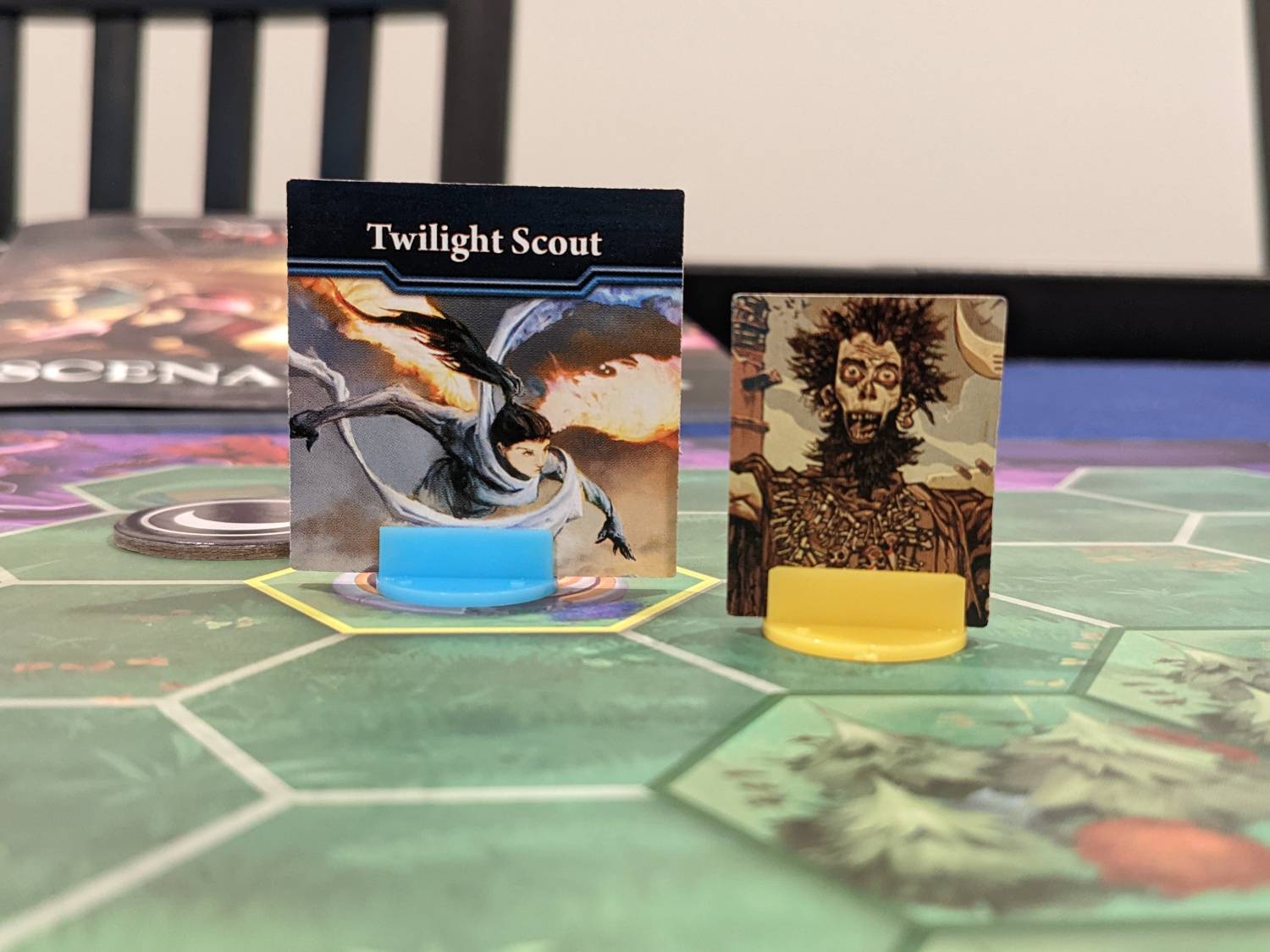
What is Ascension?
Elijah Longwell wrote a review for Meeple Mountain on Ascension: Gift of the Elements, the 2017 release and one of the 70+ expansion games and promo packs released since Ascension hit the tabletop scene in 2010, soon after the king of the deckbuilding category, Dominion, was born.
Both Dominion and Ascension provide excellent deckbuilding experiences that are still being copied today. If you’ve never played a deckbuilding game, dozens of games have taken the format to great heights, from dungeon exploration games like Clank! to Euro game experiences featuring deckbuilding as a part of a game’s mechanics, such as Lost Ruins of Arnak.
Deckbuilders are everywhere. In speaking to Gary, Ascension Tactics is a way to keep Ascension’s core gameplay loop intact—start with a terrible hand, slowly make it better by buying cards from a central card market, work to cut the fat by getting rid of those terrible starting cards—then adding on a miniatures combat game that plays out on a regular ol’ game board with hexes, terrain, and line-of-sight rules.
Therefore, Ascension Tactics is roughly 50% classic Ascension and 50% skirmish game, with “Champion” minis represented on the board and under the command of each player.
It’s an interesting mix. What I don’t know is why the seven credited designers thought there was a market for people who love deckbuilders but want to attack each other with miniatures, as opposed to attacking cards in the market row.
Because there is no such thing as bad Ascension, I’ll talk through who I think this game is really for. But first, we need to address those miniatures…or shall I say, “miniatures.”
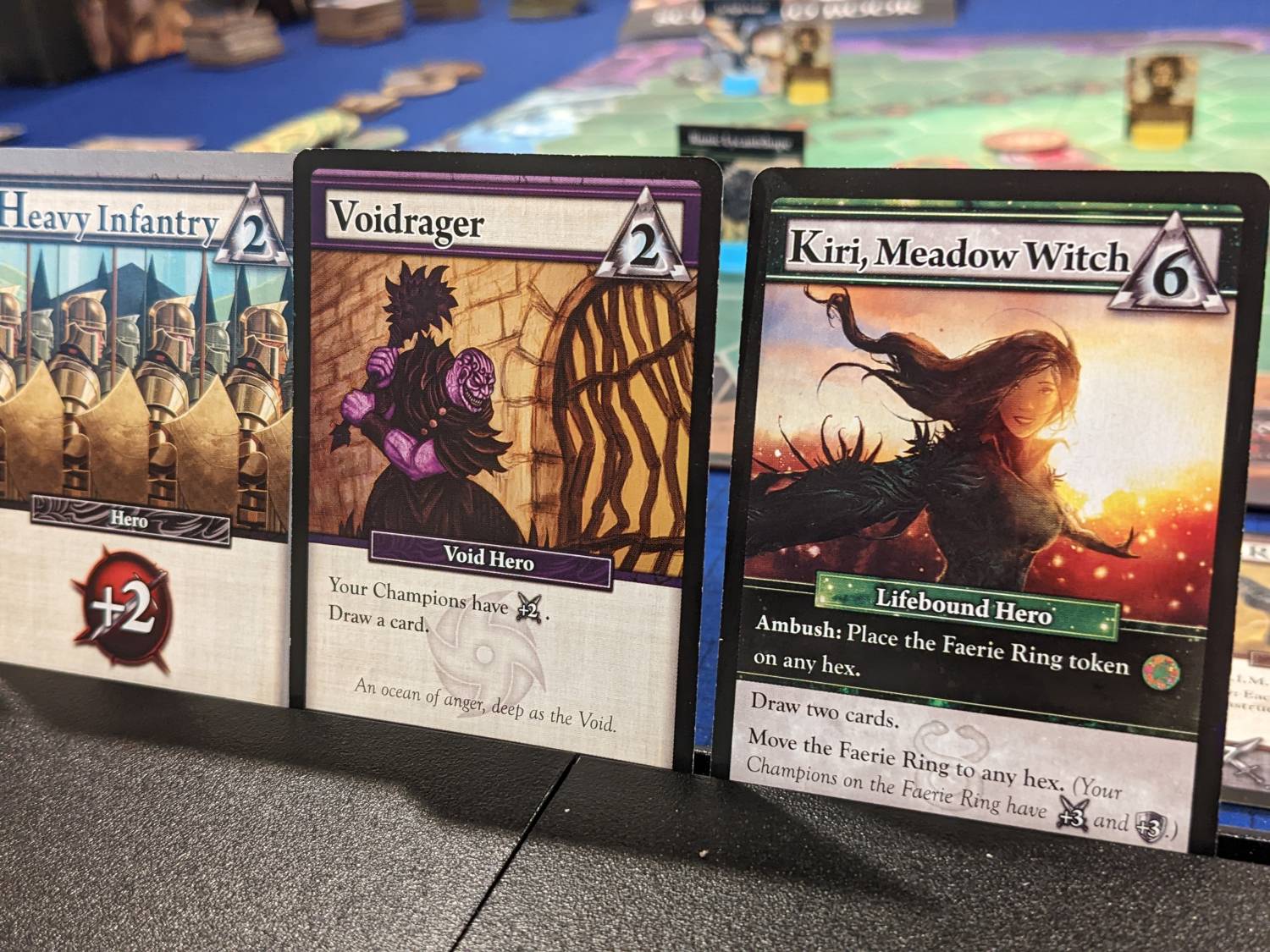
Miniatures, My (Profanity Deleted)
The large Ascension Tactics box arrived and I couldn’t rip off the shrink fast enough. The demo I walked through with Gary at GAMA Expo showed pictures of miniatures, but he did mention that he was showing me pictures of the deluxe version.
The retail/non-Kickstarter version of the game doesn’t have miniatures at all.
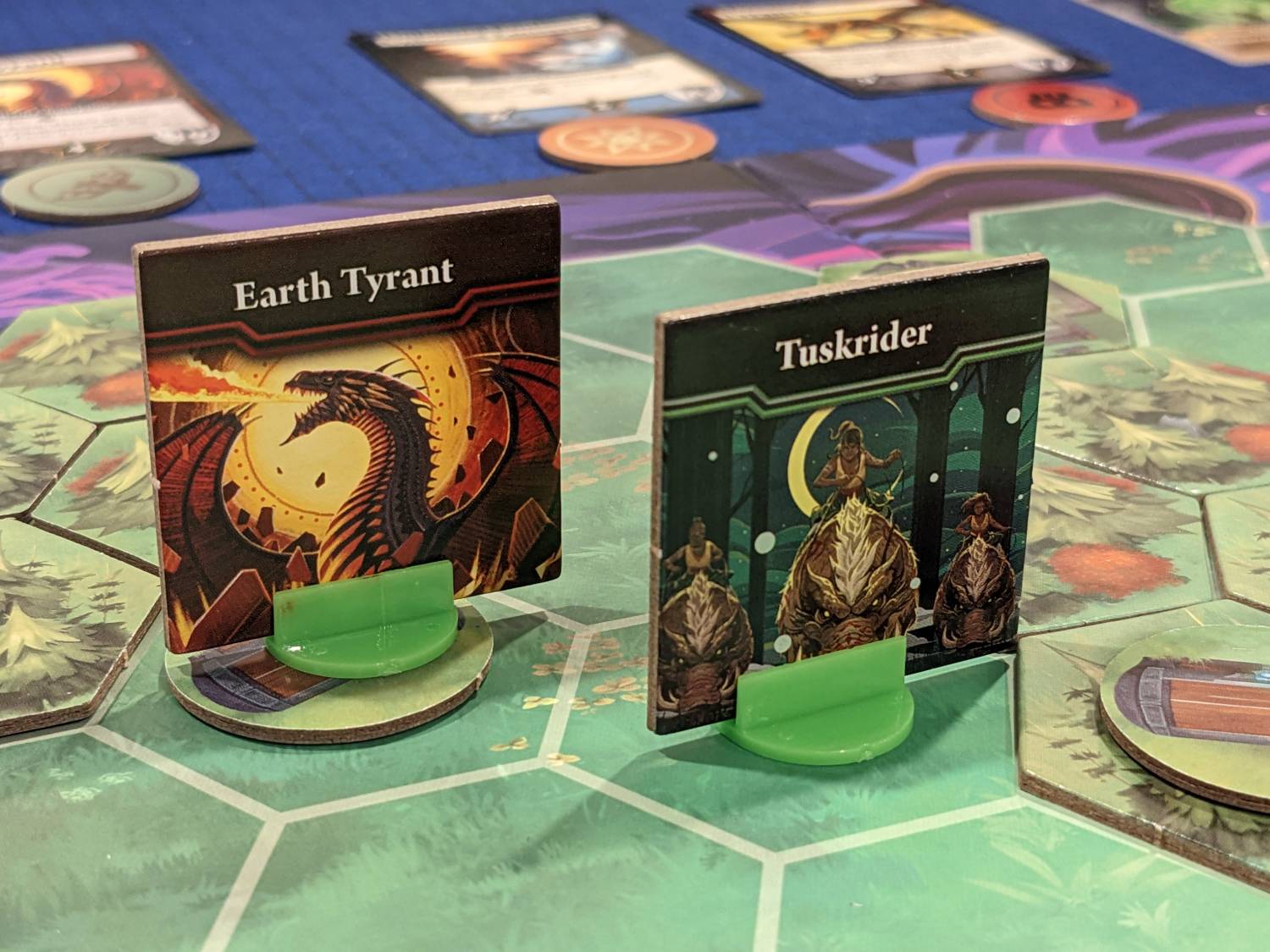
Ascension Tactics, then, starts with a lie: it’s not really a miniatures game. Most, if not all, tabletop veterans have an idea of what miniatures look like: grey, unpainted plastic sculpts that can be painted later. 3-D, to give players the sense that the picture on the card they are holding has really come to life. Lots of great features, maybe an inch or two tall, the physical representation of a character in action.
In Ascension Tactics, these miniatures are small cardboard squares placed in a plastic base, a base that struggles to hold the cardboard. These “miniatures” are a massive miss. I was expecting minis that simply weren’t as nice as the ones in the deluxe edition of the game, or even standees that were cut out in the shapes of each character, taller, more color, easier to see the names of each Champion from across the table.
None of that happened here. In fact, the entire board for Ascension Tactics isn’t great. One side of the board is pre-printed with the game’s base scenario setup, complete with ritual temples that have to be controlled to score points each around, and spaces pre-printed with trees/forests that serve to slow players trying to walk their Champions around the map.
The look and feel of the physical components are not thrilling. That said, it is priced to be an average production—you can find copies of the game for under $60. This price feels right, but I wonder if a higher price point could have led to a more significant production and not hurt the game’s market value.
Here’s what is really interesting to me: all of my friends who buy and collect miniatures games have a completely different understanding of money. On the day that I submitted this article for an editorial review, a friend of mine asked if she should buy the base pledge for Euthia: Torment of Resurrection (a sandbox RPG game featuring miniatures) for €152 or the deluxe version for €336!! All of my troops-on-a-map friends are totally fine dropping $200 on a game. So, there’s a market for this for sure> Why didn’t Stone Blade plan for that?
Complaints online about the game’s production are much louder and often more profane than my commentary here, so I may be preaching to the choir. If you can afford it, spring for the deluxe version of Ascension Tactics. It will add a ton to the overall experience.
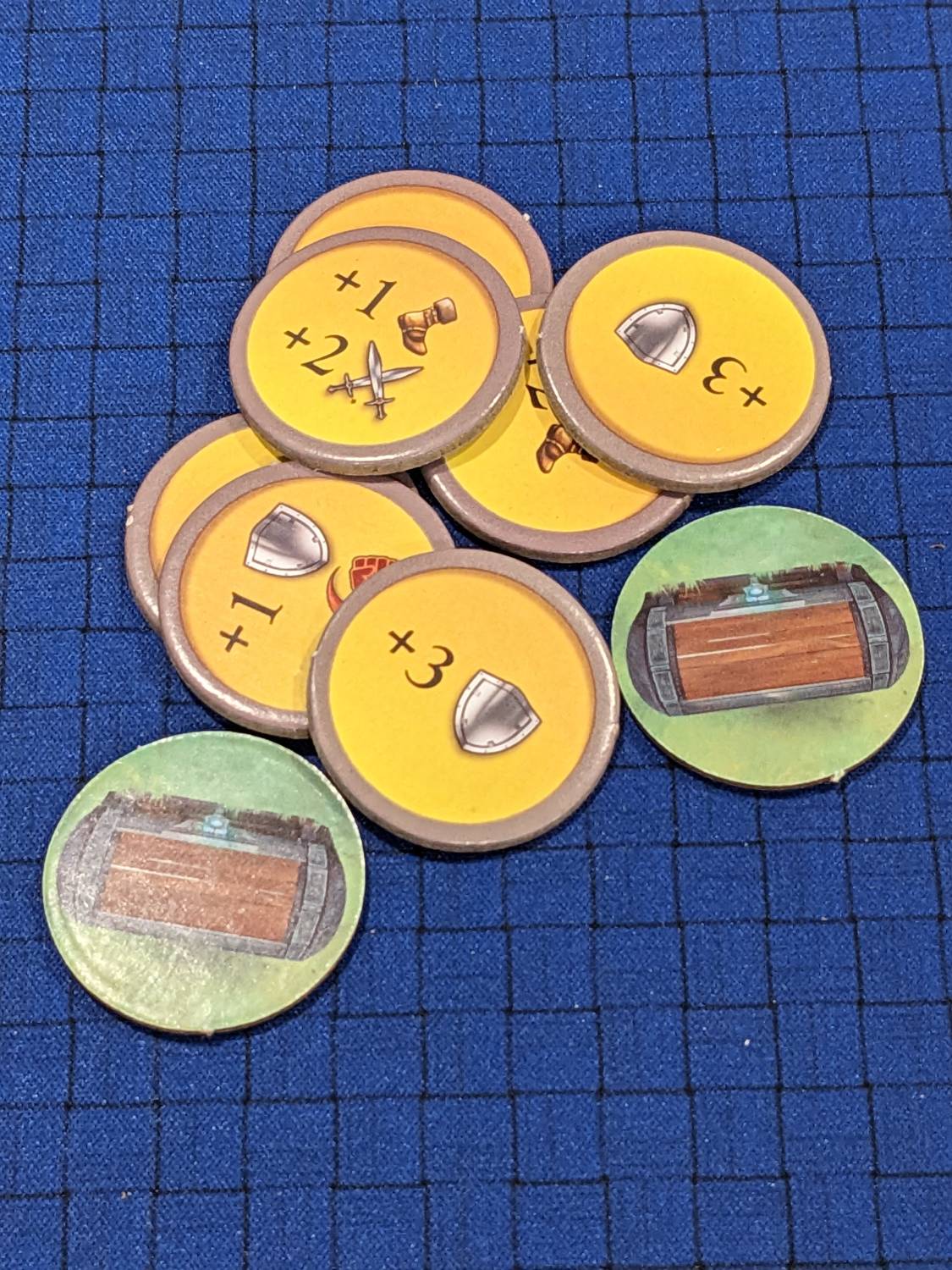
Who is Tactics For?
Ascension Tactics lines up well for a long-time Ascension fan like myself who’s looking for a way to go head-to-head in a skirmish-style game. This is especially true if you grew tired of using Power to defeat Monster cards from the center row. In Ascension Tactics, you’ll use Power to Command Champions.
Champions are the main newcomers in the new game; you’ll begin play with 3-4 Champions that have a Command cost, usually between 2-4 Power. Each turn, you’ll get two Power for free plus Power from cards played into your player area, such as Militia or Heavy Infantry cards.
These Champions are physically represented by the cardboard standees, which can be moved around the map to attack other players or stand near objectives to score points each turn. Attacking other Champions is quick business in Ascension Tactics: if an attacking Champion’s strength is at or above a defending Champion’s defense rating, the attacker knocks out the other Champion and removes their standee from the board. (Champions are resurrected on the owner player’s future turns, so losses are not permanent here.)
Many of the cards which can be purchased (with Runes, like in base Ascension) from the center row provide boosts for Champions in play, and just like other Ascension games, Constructs are featured in the center row as well. Constructs are attached to Champions in Ascension Tactics, and provide ongoing powers when Champions are on the map. When defeated, Constructs from defeated Champions simply return to a player’s discard pile, to be redeployed on a future turn.
So, if you are looking for PvP combat, Ascension Tactics is an upgrade over simply playing cards that force players to occasionally discard a card from hand, or wiping out all of a player’s Constructs, like in the base game.
The other big upgrade is the sheer variety in play formats. You can play Ascension Tactics solo, head-to-head, in teams of 2v2, co-op, even in 3- or 4-player “brawl” formats. I haven’t been itching to play Ascension in a team format, but now I can. If you have three players who love base Ascension, Ascension Tactics might work well here for a skirmish where you have a few Champions that complement each other well.
There’s also a scenario book that has different gameplay setups and a full-blown campaign. Ascension Tactics has a ton of game under the hood despite the so-so production. The value proposition is off the charts here, so kudos to Stone Blade for providing so much game for such a reasonable price.
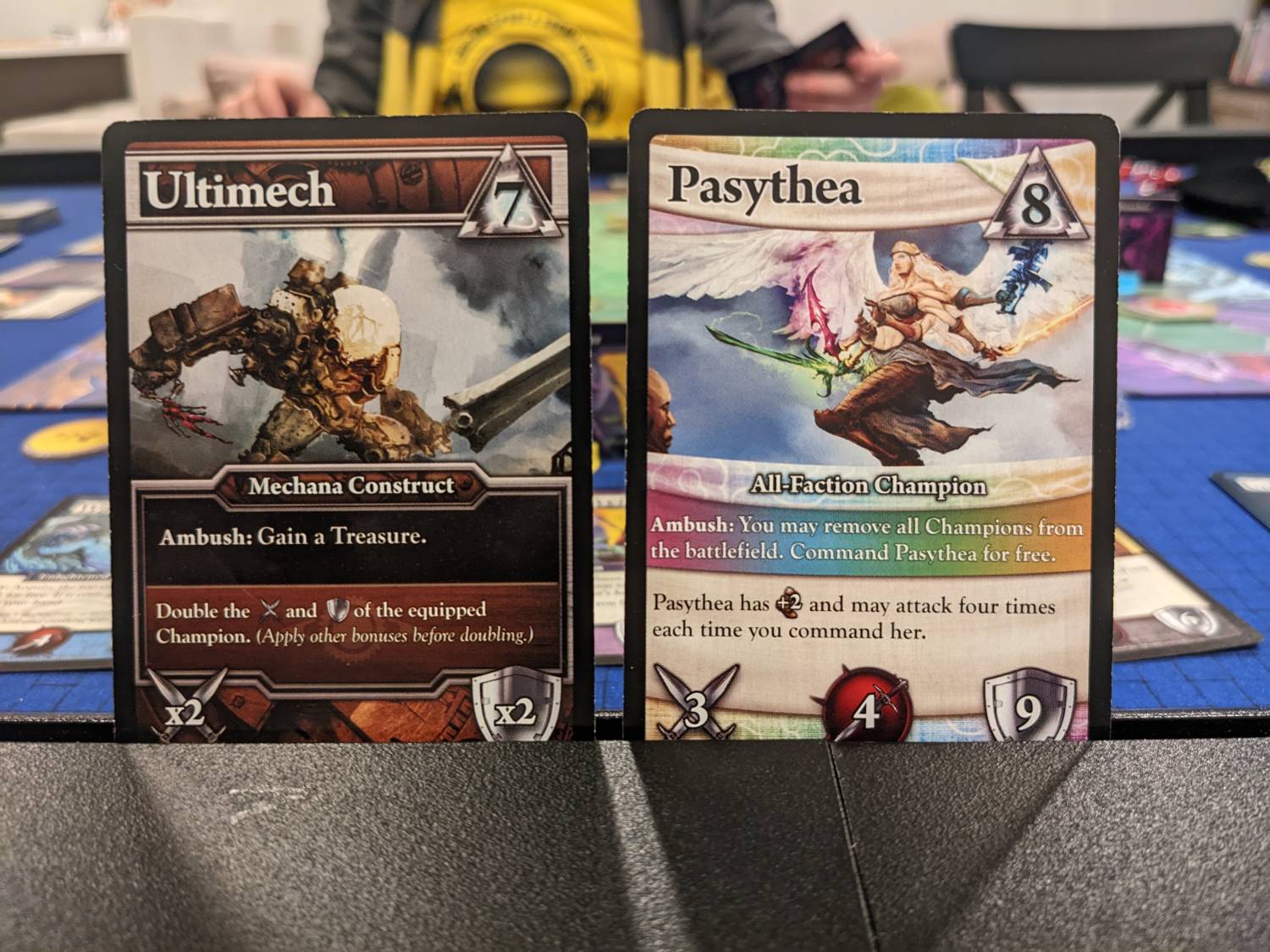
Where Tactics May Miss
I know some people who absolutely adore the base version of Ascension and won’t want to directly attack other players. (In the base game, it’s really a race to score Honor; Ascension Tactics also triggers its end game with a set threshold of Honor points that you can score by holding control points.) If direct attacks are not your jam, Ascension Tactics is a pass.
Ascension Tactics also plays slower than a game of Ascension—a LOT slower.
A two-player game of base Ascension played to, say, 60 Honor might take 20 minutes in real life. In the excellent iOS app, you can knock out a three-player game with AI opponents in less than 10 minutes. Ascension Tactics requires a lot more thought, as players plot how to move their minis around the map, often rushing to stand near control points but not any closer, out of fear that their minis will get murdered off the board.
My solo games of Ascension Tactics have usually taken 30-40 minutes; my multiplayer games (I tried co-op and head-to-head formats at two players) took 60-90 minutes. These times lined up almost perfectly to the time ranges listed in the scenario book.
A note about solo: I love the way the AI is programmed because the Scheme deck is very easy to administer and it makes sense. The bots are either rushing to an objective, or rushing to defeat player-controlled Champions. And if the AI-controlled Champions get to you, you’re usually dead because nearly every Scheme card boosts the already-high stats of each Villain.
Those games in solo also play very tight. The threshold for the base scenario is 30 Honor, and I’ve won close matches each time I have played it. I don’t think the solo does a great job simulating what players may do to pivot and outmaneuver another player, but in a high-score race, solo delivers.
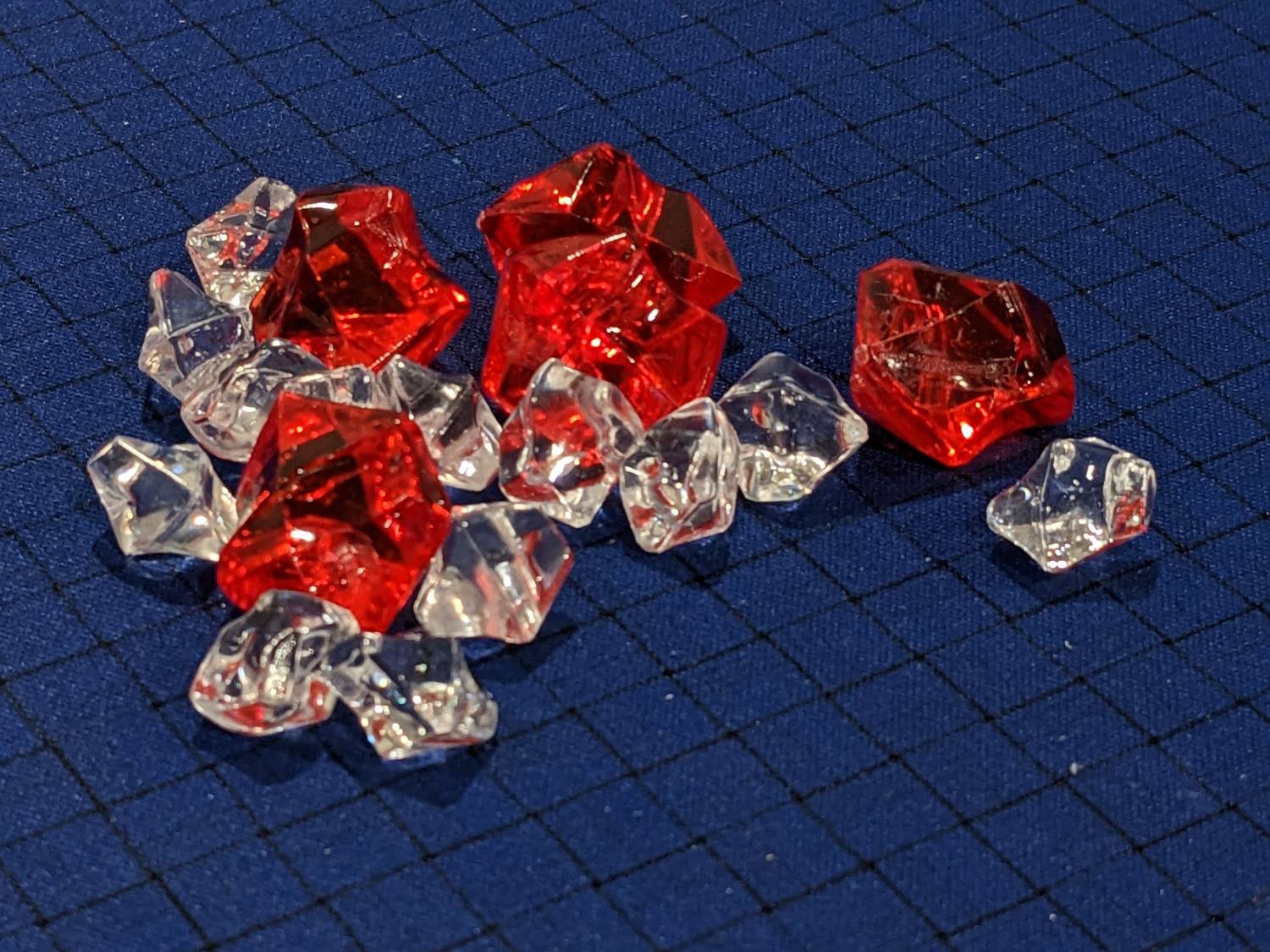
It’s Good, But Not Base Game Good
Ascension Tactics struggles with its physical footprint, but for someone like me who likes direct player interaction, the game offers a twist on a familiar concept. I love banishing Apprentice cards, grabbing five-point Honor crystals, and adding Mechana Constructs to other cards. Ascension is here, for sure, but Ascension Tactics is a bulkier version of the game I know and love.
I’m most likely going to break out Ascension Tactics when I have friends over who love the base game and have time to do a “player vs. environment” co-op team game where we can work together to take down the enemy. I like that Militia and Heavy Infantry are required to get through the game In base Ascension, you could get away with not worrying about having much Power, to focus instead on buying expensive cards with Runes that provide game-breaking powers, especially if you can regularly get them out of your hand onto your player area.
Ascension Tactics doesn’t fix what some players hate about a constantly-changing market row of cards. Sometimes, you are going to get lucky and be presented with cards that do things to all players—known as the Ambush ability—or are more affordable given the amount of Runes you have to spend on a turn. Ascension requires players to find ways to banish cards in their deck, and if you can’t buy cards that banish other cards, you’ll be in for a long night.
Sometimes, that worked in my favor for plays, and other times, it definitely did not. No change there, so that is either a positive or a negative depending on your perspective. It’s still a game that features occasional plays with a runaway leader. In Ascension Tactics, you are probably not coming back against a player who is winning 18-6 with a threshold of 30 Honor, just like in the base game where a player has built an amazing deck while you have struggled to banish your starting Apprentice cards.
But that’s part of the deal, and I’m cool with that. I was hoping for a home run with Ascension Tactics, but I’ll settle for a double up the line. If you are going to make the leap, definitely consider buying the deluxe version of this game for the real miniatures, not the cardboard stand-ins. A game about miniatures needs real minis to draw players in!




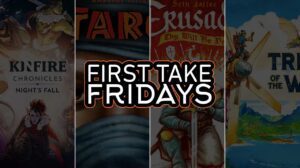







Add Comment